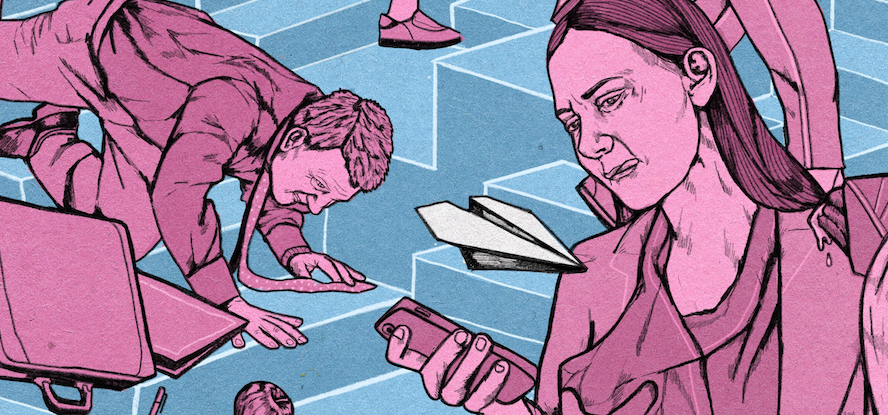Flex addiction puts pressure on educational quality
While the teacher shortage threatens to paralyze education, many teachers are still stuck in the 'flexible shell'. This leads to stress and burnout. The share of temporary contracts is also a political concern in The Hague.

Picture: Rosa Snijders
Signals about teachers who are trapped in temporary contracts are not exactly happy. Not even in the House of Representatives, as it turned out this autumn during a debate in which various parties raised the subject. But did the MPs hear it right? Did they hear then education minister Arie Slob say that permanent contracts among teachers have been on the rise for years?
So yes. “We have seen that the number of teachers who receive a permanent contract has increased in recent years,” said the minister. “Between 2015 and 2019, there has been an increase in the number of permanent contracts in secondary education from 74 to 79 percent. It has been spectacular in primary education. We were at a much lower number there. Ultimately, it rose to 83 percent. So there is an upward trend.”
GroenLinks MP Lisa Westerveld scratched her head, visibly confused. “I was surprised because this would mean a break in the trend,” she wrote about it later. SP MP Peter Kwint was also unable to place the figures, he says over the phone. As a result of this article, he and GroenLinks drew up Parliamentary questions about. “I thought it was strange to hear, because we had a completely different view.”
(The article continues below the illustration)

Picture: Rosa Snijders
advance
This different picture can easily be found in the annual report on the education labor market that the minister himself sends to the House. This shows that the percentage of teachers with a permanent appointment in secondary education decreased from 2012 to 2020 percent between 83 and 81. Primary education saw the share of permanent appointments among teachers fall sharply between 2012 and 2018 from 94 to 88 percent. Reason why it Education magazine at the time concluded that the temporary contract was on the rise. Since then, there has been a slight kink in the line, but nothing spectacular.
Primary education also saw that nod among the support staff: the teaching assistants and teacher support staff who were fully recruited by schools in previous years, partly due to work pressure resources. In this job category, the share of permanent contracts plummeted from almost 90 to about 75 percent in 2018, before stabilizing afterwards. According to the authors of the trend report - the minister's officials - the influx of new employees in connection with the delayed retirement wave is an explanation for the development in primary and secondary education. New employees usually start with a temporary appointment.
The result is that some of the teachers are leaving education and that is a great shame. You also see that the permanent team is under more pressure because they have to train new colleagues all the time
Still, there is no reason to rest assured. One in five teachers in secondary education has a temporary appointment. And that is an average for the entire sector, with some school boards the percentage is clearly higher. Not so surprising that the majority of the examples that the SP received at a hotline last autumn come from this sector. Effects mentioned: declining quality of education due to high turnover within teams, stress and burn-outs due to persistent uncertainty and teachers who cannot get a mortgage without a permanent appointment. “The result is that some of the teachers leave education, which is a shame”, says Kwint. “Especially in times of growing teacher shortages. In addition, you see that the permanent team is more taxed because they constantly have to train new colleagues.”
A recurring explanation is the fear among employers for declining student numbers and the need for a so-called flexible shell, so that they can quickly cut the workforce in the event of disappointing income. “The minister says: It is up to the collective labor agreement partners. And the employers put the responsibility back in the event of uncertain income from the ministry. We will never solve the teacher shortage that way," says Westerveld.
It is broader than education, a gigantic flex addiction has arisen on the entire labor market
“I think it is very quickly used as an excuse,” says Kwint. “The shrinkage isn't that erratic at all and you can probably absorb it to a large extent with natural attrition now that many teachers are retiring. It is broader than education, a gigantic flex addiction has arisen on the entire labor market. I understand that a school board needs some flexible shell, but I really don't see why it should be more than ten percent.”
Market parties
The appointments in the personnel formation are only part of the story. There are of course also temporary staff who are not at all on the payroll of the school board, but who are hired through commercial market parties such as employment agencies and secondments. For example, for short-term replacement when reporting sick; the replacement pools of educational institutions themselves have dried up completely due to the teacher shortage. But also to be able to staff unfilled vacancies or to anticipate the demographic decline.
That 'external flexible shell', as it is also called in HRM circles, is a lot less visible. It is unknown how many lecturers are lent through companies such as Monday, Ditiswijs or Roler Personeelsdiensten. It is clear that large sums of money are involved. A look at tender notices shows that some educational institutions, especially in secondary education, are willing to spend tons to millions of euros on long-term contracts.
(The article continues below the illustration)

Picture: Rosa Snijders
This type of expenditure, including additional costs such as officefees and VAT, school boards must include in their annual reports under the heading 'non-salaried staff'. Between 2012 and 2019, this expenditure item grew in secondary education and until 2018 also in primary education. In 2020, school boards and partnerships in both sectors together paid about 633 million euros in externally hired staff, out of a total of 17 billion euros in personnel expenditure. It is not possible to deduce from these figures to what extent this concerns managers, support staff or teachers.
The House of Representatives has also wanted more insight into this for a long time. That is why the Ministry of Education has been conducting a trial since 2020 in which school boards can provide additional information on a voluntary basis. "For example, questions are asked about the job category, the type of external hiring and the purpose," said a spokesperson for the implementation organization duo. According to him, about a third of the primary and secondary education institutions participate. From the first results In both sectors, teaching staff appears to be the largest expenditure item. From this year on, it is the intention that all boards will come together.
Other table
Back to the debate in the House of Representatives. Because what about those figures that Minister Slob presented last autumn? The minister obtained the figures from another table in the report, according to inquiries to the ministry. These figures do not concern all teachers, but only recently graduated teachers. The minister also did not mention that temporary contracts with a view to a permanent appointment were counted as permanent. A month later, the House of Representatives was still given this explanation when discussing the education budget, in the answers to the 406 written questions that the parties had asked. But then no one noticed.
This story appeared at the beginning of this month in the January issue of the Education magazine, which is published eleven times a year AObmembers falls on the bus. Learn more about all the benefits of the AOb-membership? Look here.


